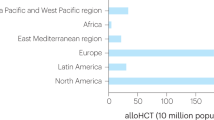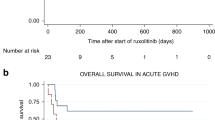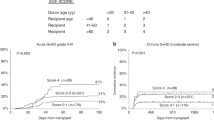Abstract
Chronic graft-versus-host disease (cGVHD) is a frequent complication of allogeneic bone marrow transplantation (BMT). Thalidomide was found to have immunosuppressive properties and it has been used in a limited number of children with cGVHD. We report our experience with refractory and/or high-risk cGVHD in 14 children. Six children showed complete clinical response to thalidomide in a median time of 2 months. Four children had partial responses and four failed. Side-effects were usually mild (somnolence, constipation) and only two patients developed sensory peripheral neuropathy. An increased incidence of infectious complications attributable to thalidomide was not observed. Nine out of 10 responding patients are alive 49–111 months post-BMT. Thalidomide can be effective particularly in children with prevailing mucocutaneous cGVHD. All patients should be carefully monitored to detect peripheral neuropathy early.
This is a preview of subscription content, access via your institution
Access options
Subscribe to this journal
Receive 12 print issues and online access
$259.00 per year
only $21.58 per issue
Buy this article
- Purchase on Springer Link
- Instant access to full article PDF
Prices may be subject to local taxes which are calculated during checkout
Similar content being viewed by others
Author information
Authors and Affiliations
Rights and permissions
About this article
Cite this article
Rovelli, A., Arrigo, C., Nesi, F. et al. The role of thalidomide in the treatment of refractory chronic graft-versus-host disease following bone marrow transplantation in children. Bone Marrow Transplant 21, 577–581 (1998). https://doi.org/10.1038/sj.bmt.1701138
Received:
Accepted:
Published:
Issue Date:
DOI: https://doi.org/10.1038/sj.bmt.1701138
Keywords
This article is cited by
-
Chronic GVHD: Where are we? Where do we want to be? Will immunomodulatory drugs help?
Bone Marrow Transplantation (2013)
-
Graft-versus-Host-Erkrankung
Monatsschrift Kinderheilkunde (2007)
-
Chronic graft-versus-host disease: where do we go from here?
Bone Marrow Transplantation (2004)



